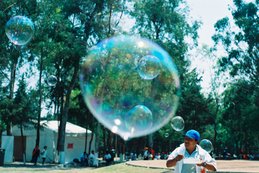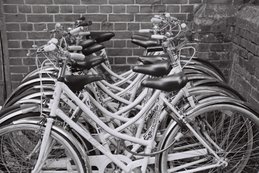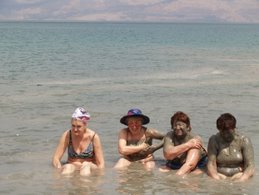It's great to see the new designs every single morning, it's surprising as well, some of them are so intricate and beautiful. People devote so much time every morning to a drawing that is going to fade that same day, until the next day when a new one will be made.
Kolam (in Tamil) is a decorative design drawn in a variety of sandpainting using rice powder or chalk by female members of the family in front of their home, especially near the threshold. A Kolam is a sort of painted prayer -- a line drawing composed of curved loops, drawn around a grid pattern of dots. Kolams are thought to bestow prosperity to the homes.
Every morning in southern India, millions of women draw kolams on the ground with white rice powder. Through the day, the drawings get walked on, rained out, or blown around in the wind; new ones are made the next day. Every morning before sunrise, the floor is cleaned with water, the universal purifier, and the muddy floor is swept well for an even surface. The kolams are generally drawn while the surface is still damp so that it is held better.
Decoration was not the sole purpose of a Kolam. In olden days, kolams used to be drawn in coarse rice flour, so that the ants don't have to work so hard for a meal. The rice powder is said to invite birds and other small critters to eat it, thus inviting other beings into one's home and everyday life: a daily tribute to harmonious co-existence. It is a sign of invitation to welcome all into the home, not the least of whom is Goddess Lakshmi, the Goddess of prosperity. The patterns range between geometric and mathematical line drawings around a matrix of dots to free form art work and closed shapes. Folklore has evolved to mandate that the lines must be completed so as to symbolically prevent evil spirits from entering the inside of the shapes, and thus are they prevented from entering the inside of the home.
I got myself a book to start learning but it's not easy when you try it on the floor, I'll start on paper and will keep photographing them in the meantime.
Wednesday, December 26, 2007
I love kolams
Saturday, December 8, 2007
lenguas
 Dicen que no hay tal cosa como ser bilingue o multilingue, mas bien es hacerse peor en varios idiomas (ahora mismo escribo estas lineas intentando decir algo que originalmente pense en ingles, asi es que seguro no se escucha igual de bien en espanol).
Dicen que no hay tal cosa como ser bilingue o multilingue, mas bien es hacerse peor en varios idiomas (ahora mismo escribo estas lineas intentando decir algo que originalmente pense en ingles, asi es que seguro no se escucha igual de bien en espanol).Ultimamente he tenido oportunidad de hablar las 4 lenguas que (creo que) maomenos domino y de aprender mas sobre una quinta lengua. Por lo cual creo que definitivamente al menos mi espanol es menos bueno que antes y mi estancia en India no ha hecho mas que empeorar mi ingles pues para comunicarse aqui hay que reducir las conversaciones al minimo de palabras y maximo de verbos en gerundio.
Ejemplo: you beach going? bus leaving now? ok, later? time?
me going she staying, tomorrow paying. Food coming?
Seguire empeorando para seguir ampliando mis capacidades linguisticas.
PD. Yael me enseno este truco fotografico que no conocia (se llama algo asi como TTV) y con el que quedamos muy guapamente retratadas.
Auroville

Auroville is an international town created in 1968 in Tamil Nadu southern India. Its philosophy as a place for people from all nationalities and with no religion as its base came from "The Mother" a french woman who work ed together with Sri Aurobindo, an Indian nationalist, scholar, poet, mystic, evolutionary philosopher, yogi and guru. The city has its geographical center an amazing banyan tree and the Matrimandir (pictures below), the weird golden structure .
Auroville has may beautiful little corners, nice houses and gardens, interesting farms, many cultural events and yet I cant help but feel that its a bubble where the real India and the Indians are either set aside (sometimes by really big fences) or are simply the people who do the hard labour around. This is of course a generalization but it is also an often heard critique of the place. It is definetely worth a visit and the more time you spend the more corners and nice people you get to know.I have spent about 3 weeks in Auroville, 2 of which I spent volunteering at Sadhana Forest, a project that aims to reforest 70 acres of land that a few years a go was completely barren. So I planted trees, worked at the vegetable garden, bathed in mud, lived in a thatched roof hut and ate vegan food.



This is Sadhana Forest









This is Sat Prem's (an Indian architect) machine for making mud bricks (with 5% cement) it's simple and effieicient, and they're making all kinds of bricks, including these ones, who work like lego so you dont need to apply a cement mix between them and ou could undo the building and take it somewhere else.

During this time I also managed to go see a tamil movie (3 hours, extremely loud volume, claping and whistling in the theather), here you can see Vijay, the local star and next to him one of his fan clubs members. I also went to a first menstruation ceremony, basically the parents throw a big party (with loads of yummy south indian food served on a banana leaf, I love that) to let everyone know that their little girl is now a woman, that she is nw a full member of the community and that suitable candidates can start setting their eyes on her for a future marriage.





Auroville has may beautiful little corners, nice houses and gardens, interesting farms, many cultural events and yet I cant help but feel that its a bubble where the real India and the Indians are either set aside (sometimes by really big fences) or are simply the people who do the hard labour around. This is of course a generalization but it is also an often heard critique of the place. It is definetely worth a visit and the more time you spend the more corners and nice people you get to know.I have spent about 3 weeks in Auroville, 2 of which I spent volunteering at Sadhana Forest, a project that aims to reforest 70 acres of land that a few years a go was completely barren. So I planted trees, worked at the vegetable garden, bathed in mud, lived in a thatched roof hut and ate vegan food.



This is Sadhana Forest









This is Sat Prem's (an Indian architect) machine for making mud bricks (with 5% cement) it's simple and effieicient, and they're making all kinds of bricks, including these ones, who work like lego so you dont need to apply a cement mix between them and ou could undo the building and take it somewhere else.

During this time I also managed to go see a tamil movie (3 hours, extremely loud volume, claping and whistling in the theather), here you can see Vijay, the local star and next to him one of his fan clubs members. I also went to a first menstruation ceremony, basically the parents throw a big party (with loads of yummy south indian food served on a banana leaf, I love that) to let everyone know that their little girl is now a woman, that she is nw a full member of the community and that suitable candidates can start setting their eyes on her for a future marriage.





Monday, November 12, 2007
Kali

















I was in Calcutta during the Kali Puja. In a brief visit I got to see my friend Ruchira and her husband Mallar so that made my visit to this badly reputed city a lot more enjoyable. I dont know if it was the fact that I had local hosts or the fact that I could only stay 2 days because of the call for a general strike (I had to get out soon or get stuck there for many days), but I didn't see people dying in the streets or hundreds of beggars as we tend to picture the city because of what has been written about it. What I did see and plenty of is Kali altars EVERYWHERE, since I was there during this Pooja.
According to Hindu mythology Goddess Kali is the first of the ten incarnations of Goddess Durga. Depicted with a fierce face and terrifying look Goddess Kali is regarded as the more aggressive form of Goddess Durga. The image of Kali usually shows her foot on Lord Shiva’s chest, a severed head in one hand, her sword in the other and wearing a garland of skulls. Kali is worshiped as the Mother Goddess who is known to destroy all evil and is a fierce fighter for the cause of justice.
According to legends once the demons named Shambhu and Nishambhu grew in force and pose a challenge to Indra, King of Gods, and his Kingdom of Heaven. Gods sought protection from Mahamaya Durga, the Goddess of Shakti or Power. At this stage Goddess Kali was born from Durga's forehead as Kal Bhoi Nashini to save heaven and earth from the growing cruelty of the demons.
After slaughtering the demons, Kali made a garland of their heads and wore it around her neck. In the bloodbath, she lost control and started killing anyone who came her way. There was chaos all around. To stop her, Lord Shiva threw himself under her feet. Shocked at this sight, Kali stuck out her tongue in astonishment, and put an end to her killing spree. The well-known picture of Kali Ma shown with her tongue hanging out, actually depicts the moment when she steps on Lord Shiva and repents.
That day is celebrated ever since as Kali Pooja. Performing the Puja with faith devotees seek protection against drought and war and blessings of general happiness, health and prosperity.
It is fun to see all of these Kalis, ranging from the ostentatious golden ones to the really gory-kitschy ones.
Here you can also see some pics from Puri in the state of Orissa. Puri is a fishermen's village and a small tourist destination, and has an ancient temple to worship Lord Jagarnath, another name for Lord Krishna (the reincarnation of Brahma the creator). Honestly I don't really understand most of the gods and the rituals but I find the little depictions of Jagarnath to be quite funny.
Wednesday, November 7, 2007
Chayote
 Despues de mas de un ano de no ver chayotes ahora me los encontre en todos lados en Sikkim (Noreste de India). Crecen en los pueblos, en las ciudades, en la calle y el cableado, y sirven tambien para hacer techos y paredes para pequenos establos (para cabras, cerdos, vacas). Ademas, nunca habia visto un chayote fuera del mercado o el super, la planta es hermosa y crece con mucha facilidad.
Despues de mas de un ano de no ver chayotes ahora me los encontre en todos lados en Sikkim (Noreste de India). Crecen en los pueblos, en las ciudades, en la calle y el cableado, y sirven tambien para hacer techos y paredes para pequenos establos (para cabras, cerdos, vacas). Ademas, nunca habia visto un chayote fuera del mercado o el super, la planta es hermosa y crece con mucha facilidad.Ver tanto chayote me hizo acordarme de mi mama, a quien le gusta mucho y que lo prepara de muchas maneras (todos platillos deliciosos). Yo ya no me aciradaba bien a bien cuanto me gusta pero despues de comerlo y verlo todos los dias durante las ultimas dos semanas decidi que si, SI ME GUSTA EL CHAYOTE.

En esta foto ademas del chayote con especias pueden ver el pan de sikkim (hecho a base de maiz y huevo, ahi haciendole la competencia a la tortilla) con huevo estrellado, mi desayuno durante los dias que pasamos en Kachuperi lake.
Subscribe to:
Posts (Atom)






















